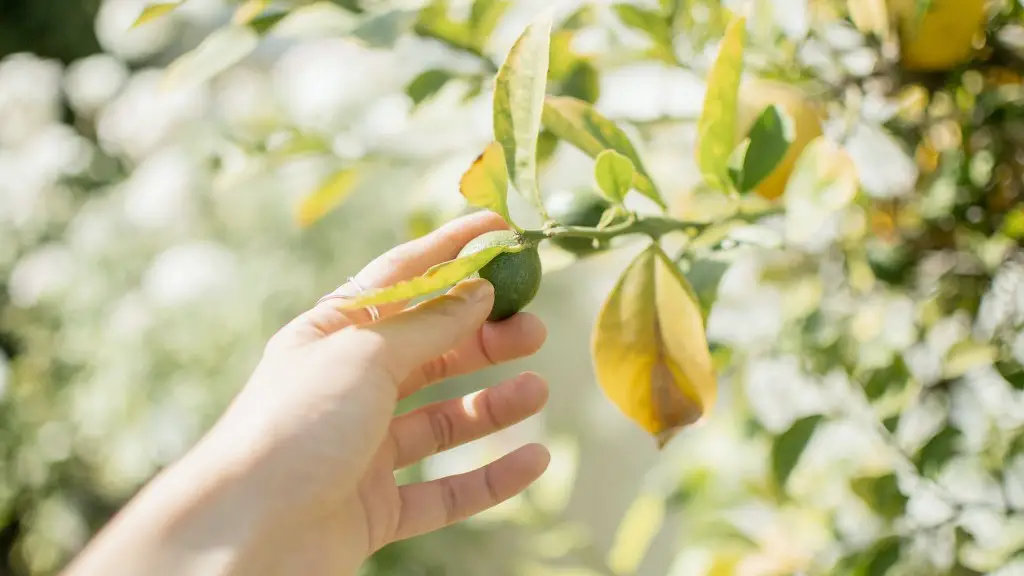Potting and re-potting a Meyer lemon tree is a great way to keep it healthy and vigorous. When bringing a lemon tree inside, it is important to understand at what point in the year the ideal time to move it is, so that the transition is successful. Moving a lemon tree too early in or too late in the season can be detrimental to the tree’s health and ultimately lower the amount of fruit produced during the year. The following are some things to consider when deciding when to move a Meyer lemon tree inside.
The most important factor to consider when moving a lemon tree inside is the temperature outside. During the winter, temperatures can dip below freezing, potentially killing the tree. In order to prolong the life of a Meyer lemon tree, temperatures should generally remain above sixty degrees Fahrenheit. If the tree is kept outside during the winter and temperatures remain warm enough for the tree, then it may be best to let the tree enjoy its natural environment unless it is necessary to move it inside.
Depending on the location, a lemon tree may also require extra protection from cold winds. If the tree is able to stand up on its own without being propped up by stakes, it may be in an area that is more protected from the winds. If wind protection is needed, the tree should be moved into an area with higher shelter to prevent wind damage. Additionally, the planting container itself should be insulated to protect the roots from extreme temperatures. Insulating containers can be found at most garden supply stores.
When bringing the lemon tree indoors, it is important to make sure that it is placed in the brightest window possible. Depending on the season, the sun may be higher or lower in the sky, so the position of the tree should account for this. Trees should be placed where they will get the most sunlight. Although Meyer lemon trees are very versatile and will survive in any light environment, they thrive best when they are provided with as much light as possible.
The space available indoors should also be taken into consideration. Meyer lemon trees can grow up to 10 feet tall, so unless there is space to accommodate a tree of this size, the tree may be better suited outside. If the tree is moved indoors, it is important to keep the space well ventilated to prevent damage to the tree. Citrus trees are sensitive to dry air and can suffer from dry root rot if the air is too dry. It may also be a good idea to invest in a humidifier to make sure the air is not too dry for the tree.
The time of year should also be taken into consideration when deciding when to move a Meyer lemon tree inside. Meyer lemon trees tend to begin producing fruit in late fall, so moving the tree inside too early in the season can prevent flowers from developing into fruit. If possible, the tree should not be moved indoors until after the last expected frost date, in order to give the tree the chance to set fruit. In general, the best time to move a Meyer lemon tree inside is in late fall, when temperatures begin to drop and the days become shorter.
Indoor Temperature
It is also important to consider the temperature of the location where the tree is to be moved inside. When moving a lemon tree indoors, the temperature should remain consistent and between sixty to eighty degrees Fahrenheit. If the temperature within the space is higher or lower than this range, the tree may not be able to adjust to the new environment and may become stressed or sick. If there is an additional light source, such as a heat lamp, the temperature should not exceed eighty degrees Fahrenheit.
Once the tree is inside, it is important to monitor the humidity levels. A Meyer lemon tree will require more humidity indoors, as the air within the home can be very dry. An indoor humidity meter can help to determine the exact levels of humidity, which should ideally be between forty to ninety percent. If the humidity levels are too low, the tree may suffer from dry rot or other diseases. Air humifiers or humidity trays placed around the tree can help to combat this issue.
The amount of water necessary to keep the tree hydrated is also important to consider. The tree should not be over-watered, as this can have negative effects on the tree’s health. During the transition period, the tree should be watered only when the soil is dry to the touch. This will help the tree adjust to its new home, and transition to its new watering needs.
The amount of nutrient-rich fertilizer should also be taken into consideration. The soil should be amended with organic fertilizer each month, if possible. Excessive use of synthetic fertilizer can cause an imbalance in the soil, resulting in unhealthy foliage and insufficient fruit production.
Prune Regularly
Pruning the tree should be done on a regular basis, as this will help keep the shape of the tree and encourage healthy growth. Pruning should be done during the early spring, when there is sufficient light for the tree. Pruning the tree will also decrease the amount of work necessary when it comes to moving the tree inside, as the tree will be shorter and more manageable.
In order to make the transition inside as successful as possible, the tree should be moved in the late fall when the weather is cool, the days are short, and the temperatures remain above sixty degrees Fahrenheit. The indoor temperature and humidity should be carefully monitored and maintained, and consistent watering and nutrient-rich fertilizer should be provided when necessary. Pruning the tree should be done regularly, and special attention must be paid to the amount of light the tree receives. It is possible to successfully move a Meyer lemon tree indoors, as long as the transition is done properly and at the correct time of year.
Winter Protection
If the tree is to stay outside for the winter, some extra protection may be necessary. Wrapping the tree in plastic or fabric will help protect it from extreme cold and wind damage. Wrapping a heat lamp around the tree may also be beneficial, as this will provide additional warmth and may help to produce more fruit when the temperatures become too extreme. Covering the pot in soil and mulch will also help to trap the heat and keep the root system warm.
Protecting the trunk of the tree from cold weather is also important. Lemon trees have a very fragile bark and can easily be damaged by colder temperatures. Placing burlap or other natural barrier material around the trunk will help to protect the bark and prevent any damage.
Monitoring the weather conditions during cold months is also essential. If temperatures are going to reach freezing or below, the tree should be brought inside and positioned in the brightest window possible. Otherwise, the tree can stay outside with the proper protection and enjoy its natural environment.
Re-potting
When the tree is moved indoors, it may be necessary to re-pot the tree in a larger container. If the tree has grown since it was last potted, it is likely that the roots will have become cramped in its current pot, and a larger container is necessary for the tree to thrive. It is important to choose a container that will provide enough space for the tree’s roots, as this will allow the tree to access enough oxygen and water.
In order to re-pot correctly, the soil must first be removed from around the tree. Once all of the soil has been removed, the roots should be inspected for any signs of disease or rot. The diseased roots should be cut away, and the remaining healthy roots should be spread out in the new container. A nutrient-rich soil should then be placed in the new container, and the tree should be carefully positioned, making sure that the root system is spread evenly.
Once the tree is re-potted and inside, regular watering and nutrient-rich fertilizer should be provided. Depending on space, a humidifier may also be necessary to keep the air moist. When the tree is moved outside, it is best to keep it in a sheltered area, with additional protection from the wind and cold. By understanding the necessary factors involved and properly re-potting the tree, it is possible to transition a Meyer lemon tree indoors with ease.
Water and Fertilizer
Watering habits should be adjusted when the tree is brought indoors. The tree should not be over-watered under any circumstance, and it is important to check the moisture of the soil before watering. While indoors, the tree should be watered slightly more often, as the soil tends to dry out faster. However, it is important to never let the soil become too wet, as this can have a damaging effect on the root system.
Fertilizer should be given to the tree on a regular basis, either in the form of a liquid fertilizer or a dry fertilizer. Meyer lemon trees require a large amount of phosphorus, nitrogen, and potassium in order to thrive. If a liquid fertilizer is used, it should be applied to the soil every two weeks, as this will provide the tree with additional nutrients as it grows. Dry fertilizer should be applied directly to the soil every one to two months, as this will help keep the tree healthy and full of energy.
As the winter months pass and the temperatures begin to rise, the tree may begin to acclimate to the new environment and need less water and fertilizer. When temperatures outside have become warm enough, the tree can then be slowly transitioned back outside, taking into account all of the factors listed above. With proper care, transitioning a Meyer lemon tree indoors for the winter season and back out again when temperatures are suitable, can help ensure that the tree will remain healthy and vigorous.
Force Flowering
Although moving the tree indoors for the winter will generally induce the tree to flower, it may be necessary to force flowering to ensure that the tree does set fruit. One of the best ways to do this is by using artificial lighting. When temperatures are below sixty degrees Fahrenheit, the tree will normally not flower. To encourage the tree to flower and set fruit, it is beneficial to use artificial lights to raise the temperature in the area around the tree. The lights should be placed at least two feet away from the tree, and they should be kept on for approximately sixteen hours a day.
In addition to artificial lights, the use of a grow tent is also beneficial when trying to force flower a Meyer lemon tree. Grow tents can create a warm, sunny environment and simulate summer-like conditions within the space, encouraging the tree to flower and ultimately set fruit. Grow tents can also be used to increase humidity within the space, which is especially beneficial for citrus trees.
The amount of time the tree is inside should also be taken into consideration. If the tree is left inside for too long, it may become too accustomed to the environment and may become too large to be moved out when temperatures become favorable again. For most climates, the tree should remain indoors for two to three months, depending on the temperature outside.
In conclusion, understanding when and how to move a Meyer lemon tree inside is essential for successful transition. Taking into consideration the temperature outside, the indoor environment and humidity levels, the kind of pot used, and the light and water needs of the tree will all help ensure a successful transition indoors. Proper protection from cold temperatures can also help to extend the life of a Meyer lemon tree, and with correct care, the tree can be transitioned in and out of the indoor season with ease.




